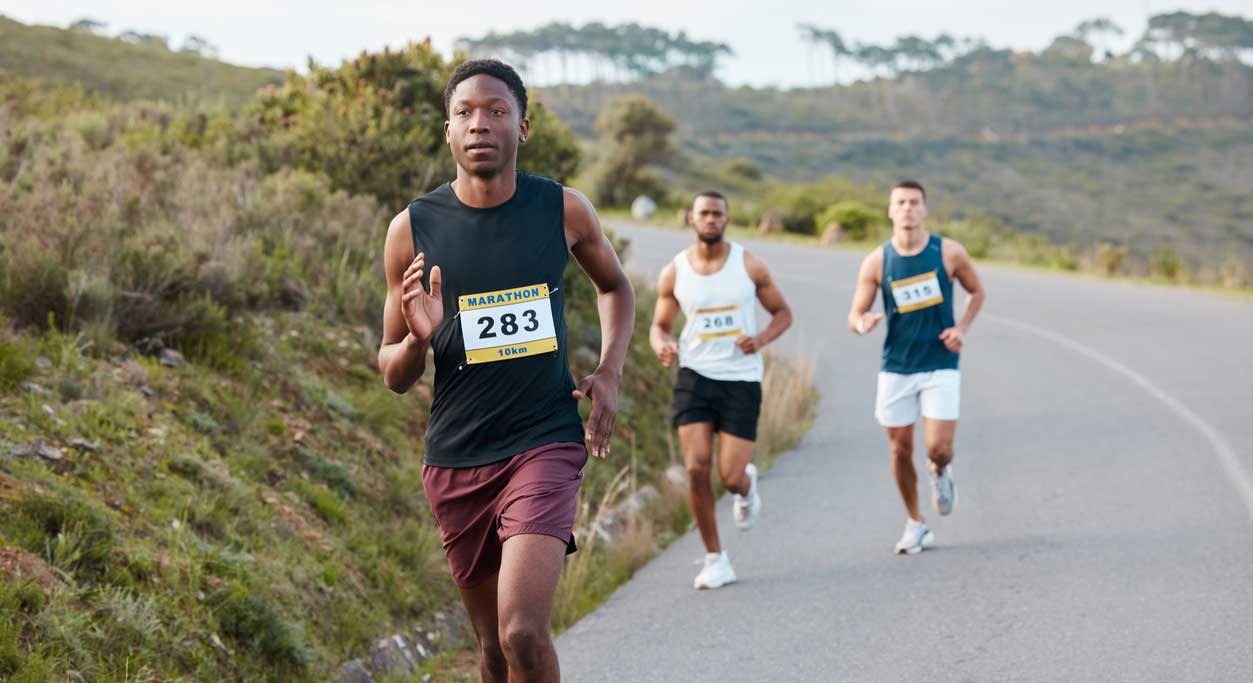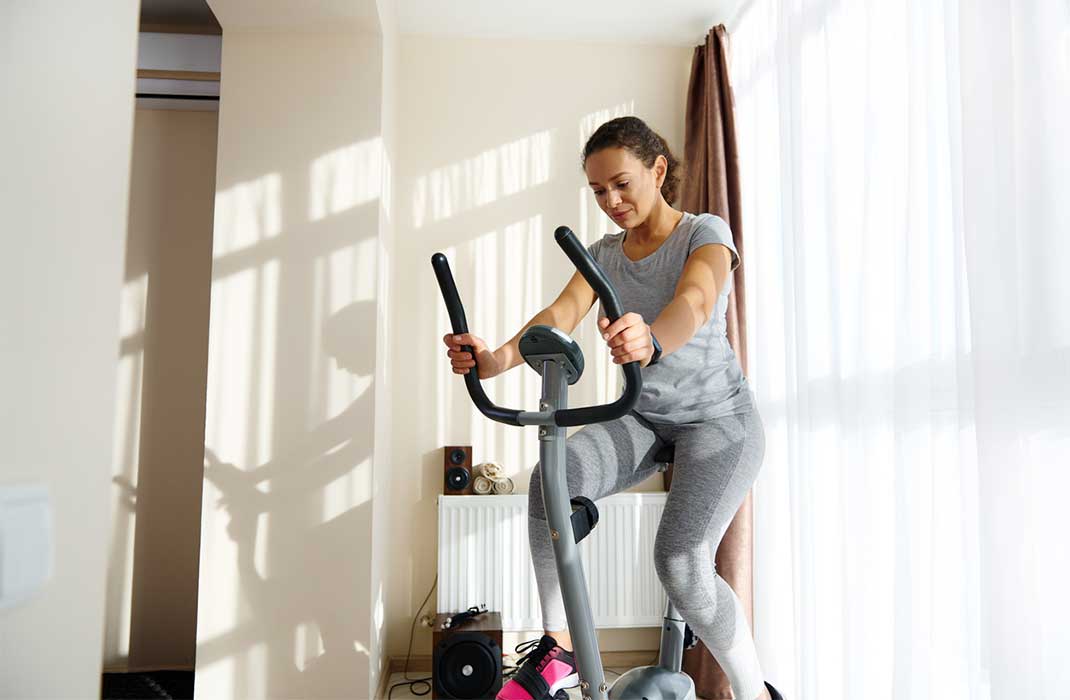Marathon Training Plan

Running a marathon is not easy. Even the most-seasoned runners can feel intimidated by the 26.2-mile race. However, with proper training, runners of all ages and skills can triumph.
“Marathons are an incredible testament to what the human body can endure, not some big scary race we should be afraid of,” says Adam S. Tenforde, MD, a Mass General Brigham sports medicine doctor. “Sure, you may feel exhausted and sore, but that doesn’t mean you have to be an Olympic-level athlete to cross the finish line.”
Dr. Tenforde serves as director of running medicine at Spaulding National Running Center at Spaulding Rehabilitation. He also cares for patients at Massachusetts General Hospital. As a six-time Boston Marathon finisher, Dr. Tenforde enjoys guiding athletes and weekend warriors back to the starting line from running-related injuries.
He explains how runners can put themselves in the best position to succeed before, during, and after a marathon.
Health risks to consider before training for a marathon
Before signing up for a race, talk to your primary care provider (PCP). They can evaluate any health concerns you may need to address, help you control many conditions, and connect you with providers who specialize in those conditions.
Some common conditions that affect runners are:
Untreated eating disorders: Running with an untreated eating disorder can increase risk of an irregular heart rhythm, or cardiac arrhythmias. Meeting with a dietitian or a mental health care provider can ensure runners receive the nutrients they need to exercise safely.
Existing bone or muscle injuries: A sports medicine doctor can evaluate whether a bone or muscle has fully healed. Returning too quickly can lead to reinjury. Too much force on a sprained ankle, for example, may lead to a complete bone break.
Underlying heart conditions: Your PCP may refer you to a sports cardiologist if you have untreated high blood pressure (hypertension), a family history of heart disease, or an unexplained, early death of a first-degree family relative. Sports cardiologists can teach runners how to manage a heart condition throughout the race.
Asthma: Exercise may induce asthma, a chronic condition that restricts the airway. Using a prescribed inhaler before running can help relieve some symptoms.
How does a marathon affect the body?
According to National Geographic, marathons earn their name from an ancient Greek legend: the Battle of Marathon. A soldier ran 26 miles from the town of Marathon to Athens, only to collapse and die upon arrival.
The legend is just that — a legend — but it offers an important lesson: Know your limits. A marathon puts immense stress on your body and organ systems for hours on end. It can sometimes lead to dangerous health problems.
Here’s how marathon running can affect key organs:
The brain: Running can improve your mental health. The brain releases chemicals that trigger a “runner’s high,” which may help you think more clearly. However, fatigue can disrupt a runner’s focus over the course of a marathon and erode their motivation to finish. Sweating and dehydration can lower the amount of sodium in the blood, too. Sodium is an electrolyte — an electrically-charged mineral dissolved in water — that promotes nerve function. The brain is sensitive to low sodium levels. Drinking too much water, or overhydrating during a marathon, can result in low serum sodium, referred to as hyponatremia. Low enough levels of sodium may trigger feelings of sluggishness or confusion from the brain. This can result in death if not detected and treated.
Kidneys: In addition to sodium, the body relies on several other electrolytes for vital functions. The heart, for example, relies on just the right amount of the electrolyte potassium to create a heartbeat. Too much, or too little, can harm the heart. The kidneys help strike a balance by filtering electrolytes and water from the bloodstream. Dehydration forces the kidneys to preserve this balance by withholding water they normally dispose of in the form of urine. Overhydrating, on the other hand, can diminish electrolyte concentrations, forcing the kidneys to produce more urine. Runners who drink too much or too little water can place unnecessary stress on their kidneys.
The heart and lungs: The heart and lungs work together to deliver oxygen throughout the body. Oxygen regulates body temperature, converts food into energy, and removes toxins. The heart-lung tandem works much harder during intense activities.
Joints (the space between bones): Exercise can keep cartilage — the padded lining between bones — healthy. That said, running with an underlying joint condition, such as arthritis, can do more harm than good to the hips, knees, and ankles.
Bones, muscles, and ligaments: Unhealthy bones, muscles, and ligaments (tissue connecting one bone to another) can’t sustain the same amount of force as they can when healthy. Too much force may cause a bone to fail, usually in the form of a bone stress injury or a stress fracture. It can also injure a tendon or sprain a ligament. Overexerting muscles in the lower body can lead to painful muscle strains and cramps, too. Age-related changes to tissues may occur over time. A runner typically experiences damage to these tissues as pain confined to a specific location.
How to train for a marathon
Humans are incredibly resilient. For thousands of years, survival has depended on their ability to adapt under extreme conditions.
Running long distances requires a similar adaptation, explains Dr. Tenforde. Gradually training to withstand a marathon’s physical demands makes running the race possible.
Preparing for a marathon
There is no one-size-fits-all training plan. Every runner starts at a different fitness level. Responsibilities at work and home can limit how often you train during a given week.
Plans may ask runners to begin training 20, 16, or 12 weeks ahead of race day. Trainees typically run a specific number of miles each week. The plan spreads the mileage across several days, leaving a few days in between for rest. Every few weeks or so, plans slightly raise the total number of miles per run.
Plans usually schedule long runs, or races, over time as milestones. Examples of distance milestones include:
5k (3.11 miles)
10k (6.21 miles)
10 miles
Half-marathon (13.1 miles)
Longer distance runs of 16 to 22 miles
With each milestone, the body learns how to handle more stress placed on the heart, lungs, muscles, bones, and brain without feeling overwhelmed.
“Training is how your body teaches itself to run more efficiently by completing each distance and adapting to perform this distance or effort in the future,” says Dr. Tenforde.
What does it mean to “hit a wall”?
The body operates a lot like a car engine. It burns fuel into energy, which allows it to perform everyday functions, like breathing or walking. Sugars, fats, and proteins are different sources of fuel, or calories. The body can convert and store energy in muscles throughout the body and in the liver.
During exercise, the body taps into fuel stored in muscles, called glycogen, for extra calories. The body burns calories one of two ways, depending on the type of exercise:
Aerobic exercise: During slower, sustained activity — a walk or jog, for example — the body breaks down calories at a slow, steady rate with plenty of oxygen at its disposal. This is referred to as aerobic metabolism.
Anaerobic exercise: During shorter, intense exercise — a sprint, for example — the body breaks down calories rapidly, without oxygen.
Not only does breaking down calories produce energy, but it also produces unwanted waste products. Prolonged aerobic exercise, or brief bouts of intense anaerobic exercise, can allow this waste to build up. One waste product, called lactic acid, builds up in the bloodstream or muscles during exercise. After a workout, you may feel the burning sensation of lactic acid in your muscles.
With enough fuel and oxygen at its disposal, the body primarily uses aerobic metabolism to create energy. But, over the course of 26.2 miles, the body depletes glycogen reserves. The body can switch to other forms of metabolism to sustain exercise.
If the body is not adequately prepared to complete the marathon distance, excess fatigue can develop in later stages of the race. The sensation of overall body fatigue can occur at any stage but has been described at miles 18 to 20 of the marathon as “hitting the wall.” Some can’t run any further, opting to walk the remaining distance. Others opt out of the race entirely.
“The fatigue, pain, and stiffness you’re feeling is your muscles trying to get you to stop,” says Dr. Tenforde. “That’s the feeling of hitting the wall.”
During training, the body can adapt to completing the full marathon distance. For example, the heart learns to pump blood more effectively, delivering oxygen to muscles in a shorter amount of time. Muscles and tissues learn to burn fuel more efficiently.
Marathon equipment
Few sports require as little equipment as running.
“If you have equipment that protects your skin, allows you to exercise, and protects your feet, then that’s all the equipment you need for a successful race,” says Dr. Tenforde.
The right equipment can make a huge difference. The feet need protection from hitting a paved road over the course of a marathon to prevent blisters and other damage. Most running shoes use biomaterial or synthetic foams to absorb the force of the landing foot. Over time, wear-and-tear can ruin this material. Sweat and temperature changes accelerate damage, too.
Advances in footwear — such as development of carbon fiber plates in shoes — can improve performance but may carry risk for bone stress injuries in the foot.
Dr. Tenforde suggests switching to a new pair of running shoes every 350-500 miles of training. Try not to tie shoelaces too tight, either. The foot needs just enough space to wiggle its toes. This prevents blisters and promotes blood flow.
Runners may try “super shoes,” or technologically advanced running shoes. These shoes combine cushioning with a resilient midsole and a carbon fiber plate. High-level distance runners often choose these shoes, and they can take time to adjust to. Take caution when using these shoes if you have a history of prior injuries, such as overuse bone stress injuries in the foot.
Several other pieces of equipment can benefit runners, too. Consider using:
Weather-specific clothes: Stay warm during cold winter workouts by wearing base layers, gloves, and a hat. Some synthetic materials will help wick moisture from the skin. Consider running indoors or use shoes with greater traction to reduce the risk of slipping on icy roads and sidewalks. Wear light, loose-fitted clothing to stay safe while exercising in the heat.
A wristwatch: Runners chasing a specific time can pace themselves using an accessible watch.
Sunscreen and sunglasses: Sunscreen protects bare skin from the sun. Sunglasses protect the eyes from similar exposure. Even on cloudy days, harmful ultraviolet (UV) rays can damage the skin.
A hat: Shade from a hat, like sunscreen and sunglasses, helps block UV rays from the face.
Petroleum jelly: Chafing occurs when fabrics rub against the skin for an extended period. Applying a little bit of jelly where the rubbing occurs can help prevent uncomfortable sores. Rubbing most often occurs between the thighs, the arms and torso, and the chest and shirt.
Dr. Tenforde reminds runners to avoid distractions when running in unfamiliar environments. Common distractions include listening to music and constantly checking a smartwatch or smartphone. Stay aware of your surroundings to reduce the risk of danger from strangers or motorized vehicles.
What to do the day before a marathon
Don’t try something completely new the day of, or leading into, your race. Wearing a new pair of shoes for the first time, for example, may lead to blisters and general discomfort.
Likewise, do not eat foods you are not familiar with. If your gastrointestinal (GI) tract responds poorly, you may experience an upset stomach in the middle of the race.
“Go with what you know,” says Dr. Tenforde. “Why jeopardize what you’ve worked so hard for by switching your routine at the 11th hour?”
Remember to:
Stay hydrated, but do not overhydrate: Drink enough water so urine is light yellow, but not so much that it looks like clear water. Typically drink to thirst using electrolyte solutions.
Sleep well: According to Dr. Tenforde, how well you sleep two nights before the race can affect your energy levels on race day. Stick to a consistent, uninterrupted sleep schedule at least 48 hours before the race.
- Create a gameplan: Know exactly where you need to arrive at the start of the race and how you plan to get there. If you plan to run with headphones, charge your electrical devices. Select a meet-up spot for family and friends after the race.
What to eat leading up to a marathon
Many runners consider a “carbo-loading” diet days before their race. The diet encourages runners to eat foods rich in complex carbohydrates, which are long chains of molecules the body digests into sugars. The body digests these molecules slower than it does simple sugars, giving it a steady supply of fuel.
No conclusive evidence proves a “carbo-loading” diet works for all runners. In general, eating foods with complex carbohydrates, protein, and smaller amounts of fat will allow for normal metabolism leading into a race. This will also reduce the risks for GI distress.
Foods rich in complex carbohydrates include:
Whole-grain bread, rice, and pasta
Fruits
Starchy vegetables (potatoes)
While it’s important to eat enough complex carbohydrates, try not to overeat. Eating too much pasta the night before a race, for example, can upset your stomach. Besides, balancing your diet with protein from meat, fish, beans, and leafy greens helps slow down how fast the body burns through added carbohydrates. Iron, calcium, and vitamin D from these foods can protect bones and muscles, too.
Some runners may use sports drinks or gels to keep their electrolytes at a healthy level. Avoid sugary drinks, particularly those with added sugars exceeding daily recommended limits.
Avoid use of pain medications
Recovering from a marathon
After the race, Dr. Tenforde encourages runners to:
Keep walking and massage muscles: Prevent muscle breakdown by massaging quadriceps, calves, and hamstrings. Avoid sitting down, if possible. Stiff, rigid muscles make it difficult to stand up from a sitting position. Walking helps loosen muscles.
Take a bath: Consider alternating between warm and cold baths, ending with a cold one. Also consider cold water submersion to relieve pain and stiffness in the muscles after exercise.
Eat plenty of food: Foods loaded with carbohydrates will replenish empty glycogen reserves. Protein and fats help repair tissue in worn-down muscles.
How soon can I run after finishing a marathon?
First and foremost, celebrate the accomplishment. Running 26.2 miles is no small feat, says Dr. Tenforde.
In the days following the race, you may expect:
Achy, stiff muscles
Difficulty standing from a sitting position
Slow, labored walking
Topical gels and anti-inflammatory, over-the-counter drugs, such as ibuprofen, can help runners manage pain or tightness felt in muscles.
According to Dr. Tenforde, there are no clear guidelines for when it is safe to run again. But that does not make it okay to halt all activity. Rather, he recommends an active recovery. Low-impact exercises, like cycling, walking, or swimming, can help muscles heal.
“It can help to take a 1 to 2-week break from running, or doing any significant training for a similar event,” he adds.
If pain does not improve or prevents you from walking or bearing weight, see a medical professional immediately. This can be a sign of a bone stress injury.
Learn about Mass General Brigham Sports Medicine services


